Caring For My Dog
At the basic level, caring for your dog is about food, water, shelter, veterinary care, socialisation and training
This section has information on all aspects of caring for your pooch, from the basic through to information on key diseases. BUT there’s more! If you want special information on a particular topic, just ask and we will try to bring it to you.
Care For Your Dog
Dogs are engaging pets that require special care. More than 3 million households in Australia own and love their dogs and 60% of the pet industry is dedicated to dogs. They are not hard to own, but you must “follow the rules” for dog care, especially if you have small children or other pets.
What is a dog?
Dogs are from the Genus Canidae. They can have a long life span – up to 17 years – with the “general rule” that the smaller the dog is the longer it may live. There is an argument raging as to whether dogs are carnivores (meat eaters) or omnivores (meat and veg, grains), with each side of the argument quoting “their” research.
What is true, though, is that dogs are well adapted to modern mixed diets that include meat, offal, grains and vegetables. So we think of them as carnivores, but not as obligate carnivores.
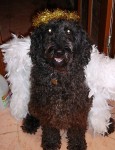
What kinds are there?
There are more than 200 recognised dog breeds in Australia, as well as hybrids (deliberate purebred crosses (eg labradoodle) and crossbreds (“accidental” crosses eg “mutts”).
What does a dog cost?
Most people allow up to $5000 to buy and around $1800-$2000 per year to “love” a dog, including vet bills, food, treats, training etc. it might cost more or less in an individual year depending on what happens, with puppies and old dogs needing the most attention and healthy adult dogs the least.
How do I know if my dog is healthy?
A healthy dog is bright and alert. Check for a clean rear end, clean ears, eyes, nose and mouth. Ears, tongue and gu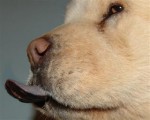 ms should be pink, unless they are a breed with black skin and mouth, eg Chow Chows. Check the coat around the eyes for signs of wetness or tear staining – this can mean blocked tear ducts or eyelash irritation. The coat should be shiny and the animal neither thin nor fat. A warm dry nose is not necessarily a sign of problems.
ms should be pink, unless they are a breed with black skin and mouth, eg Chow Chows. Check the coat around the eyes for signs of wetness or tear staining – this can mean blocked tear ducts or eyelash irritation. The coat should be shiny and the animal neither thin nor fat. A warm dry nose is not necessarily a sign of problems.
Check the teeth, which should be clean and meet neatly (except in breeds where overbite is OK, like Lhasa Apsos). Breathing should be even and quiet with no difficulty or rattles.
A healthy dog will move freely with no signs of lameness. Look at the pen and surroundings. Dogs kept in clean conditions with no overcrowding resist diseases better.
Check how the dog responds to people and handling – choosing a relatively calm pet makes a better transition to your house. If you are buying from a breeder, ask them what their breeding goals are – you should select those that are bred for temperament and health.
How do they normally behave?
Like all pets, dogs have a recognisable body language that you can decipher. See how many of the below you can recognise!
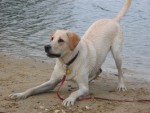
thanks to K9 Mobile Grooming for the pic!
Head down, bottom up, tail wagging: Play with me!
Rolling onto back, showing belly and throat: “I’m sorry” or “you are the boss!”
Leaning on you: “You’re nice, stay close to me”, or “that’s the spot, it’s itchy!”
Ears back, hair on neck sticking up, tight face: “Stand back, I might bite”
Yawning: “I’m tired”, or “I’m just about to concentrate”
Tail tucked in and ears back: “I’m frightened, be careful please, I might bite”
Sitting, lifting a paw: “Nice to meet you, can we play now please?”
Training and behaviour
Remember, digging, chewing, barking, howling, jumping, and urinating on things are all normal behaviours in dogs – it is up to us with patience and care to teach them when these behaviours are OK and when they are not.
All dogs should be trained – by you, or by an obedience trainer. Dogs LOVE to be accepted as part of your “pack” and are generally keen to please, so patience and the occasional food reward can go a long way. Dogs will also “train themselves” by learning your tiniest body language. It can take up to a year for you and your dog to really understand each other, regardless of whether you buy a puppy or an adult dog. There is a strong association between the time you spend with your pet and how good a pet it will be.
How do they like to live?
Dogs are social animals who need company and form strong social bonds. Dogs can live alone if they are included in family activities but living alone outdoors is a lonely existence that often results in bad behaviours like barking, digging and chewing.
How big should a yard be? This depends on the dog, not necessarily the breed. Generally the bigger the dog the bigger the yard. Working dogs like Border Collies, Kelpies, Australian Shepherds and Cattle Dogs need lots of exercise as they are bred for sheep and cattle work. ANY dog in a small yard nee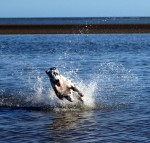 d more exercise – not just on leash, but also “free running” in leash free areas, ball play, or beach runs.
d more exercise – not just on leash, but also “free running” in leash free areas, ball play, or beach runs.
The yard MUST be secure – dogs escape when they are frightened, eg during storms, and can be hit by cars or taken to the pound, where will cost you a heap of money to get your pet back. Either way, a couple of hundred dollars spent on fencing is a worthwhile investment.
Bedding can be anywhere sheltered – a kennel, garage, laundry – that can’t be closed accidentally and can’t let the weather in during storms. You should provide bedding – a blanket, bed, foam or mattress – that can be cleaned.
Dogs and Water
DOGS NEED LOTS OF CLEAN WATER! Check water daily and allow at least two litres per dog per day – and more than twice that amount in summer. Water should be changed daily and the bowl cleaned at least twice per week for good health.
Dogs and temperature
Dogs generally don’t tolerate heat well because they don’t sweat and are covered with fur. They can die within just 7 minutes in cars in spring, summer and autumn, and even in winter. They can burn their feet on hot pavements. Dogs need cool water and shade, and not too much exercise in the heat of the day. Cool baths or swims can also help. Keep dog kennels etc out of the sun if possible and particularly afterno on sun.
on sun.
Brachycephalic (squashy nosed) dogs like Pugs, Bulldogs etc do not tolerate heat AT ALL, and can heat stress at 25C!
Some dogs don’t tolerate cold well – especially thin-coated, old or young dogs. Warm bedding and possibly a coat in winter will help keep them comfortable and happy. Cuddles help too!
What about playtime?
The more time you spend with your dog, the better pet it will be. Leaving toys or large uncooked bones in the yard can help with loneliness. Play with your dog with ball games, walks, runs, chasing, – these are fun for both of you. Games involving teeth eg biting games, tug of war etc are not good for training and should be avoided.
Most dogs over 18 months old also love “gymnastics” (“agility”) – jumping through and over obstacle), weaving, ducking, “hide and seek” games and “chasings”. Most dogs also love obedience training, because it makes them use their brains and they are with their people.
Dogs and Children
Dogs are great pets for children – to love, to feed and to play with. REMEMBER dogs don’t usually recognise children as “real people” until around puberty and this can result in bites. Children should NEVER be left alone with a dog, should be taught NEVER to scream around dogs, should be taught how to approach dogs safely (including NEVER touching a “stranger” dog without the owner’s permission) and should help take the dog to obedience school.
What do dogs like to eat?
The general rule of feeding is variety and quality. Feed a varied diet as a pup to avoid fussiness later, and use a “complete diet” where possible. Raw meaty bones (NEVER chicken) are fun, as is the OCCASIONAL treat like an egg, leftover meat, cheese or rice. Many dogs are natural scavengers and will happily eat things that you wouldn’t dream of.
Feed adult dogs once or twice per day and adjust the amount by what you see – if you can feel the ribs easily but not see them, the dog is just about perfect weight. If you can’t feel the ribs cut reduce the food amount a little, if you can actually see the ribs increase the amount or number of feeds until Fido is back to “just right”. You will be surprised at your pet grows older how little feed they seem to need to be healthy. Remember that when you give your pet a treat, you should adjust that night’s dinner accordingly. DO NOT exercise your pet after dinner – they can get tummy upset just like you!
Keeping your pet clean
First things first – a clean environment means a cleaner pet. Pick up droppings and don’t allow “dust bowls” to occur in the yard if possible.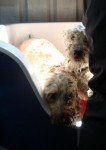
Bathing depends on the dog– if it is dirty, smells “doggy”, runs regularly in mud or seawater, or your hand is dirty after a pat, then regular bathing will help maintain skin and coat. USE A DOG SHAMPOO and rinse out really well to avoid skin irritation.
Brush the knots out of the coat first to avoid making them worse in the bath. For many dogs a quick “towel dry” and a good run in will dry the coat naturally, long coated dogs and breeds that have a particular hair style need a professional grooming technician or groomer to help your pet look like royalty.

The grooming started: then the groomer realised the entire coat was matted together…
WARNING matted fur in warm weather, particularly if wet, can attract flies. If fly strike occurs, the toxins from the maggots can kill within 24 hours Grooming is critical in summer!
Teeth eyes and ears also need attention. For most breeds bones, dental chews or products from your pet shop or vet are good for teeth, but you may also have to clean the teeth with a special “finger brush”. Eyes and ears are generally wiped with a clean damp cloth.
Desexing
Dogs that are not desexed can spend too much time thinking about sex and less time thinking about being good pets. Desexing before 4-6 months old avoids unwanted litters, avoids a heap of veterinary bills, calms the temperament and reduces fights. It is a great investment!
Veterinary treatment
Have your dog checked by a veterinarian within the health guarantee period from a breeder or pet shop, or as soon as possible after purchase from other sources. This will ensure you haven’t bought problems.
Routine veterinary treatment includes intestinal (“gut”) worming every three months (more often for puppies), heartworm prevention (how often depends on the product), vaccination yearly (some diseases are yearly vaccination and others are longer), and regular treatments for fleas, as well as routine checkups for teeth and to make sure all is well.
Some odd facts
Dogs have an additional bone compared to most species – in the penis. This is a great reason NOT to throw the bucket of water on dogs caught in the act of mating!

